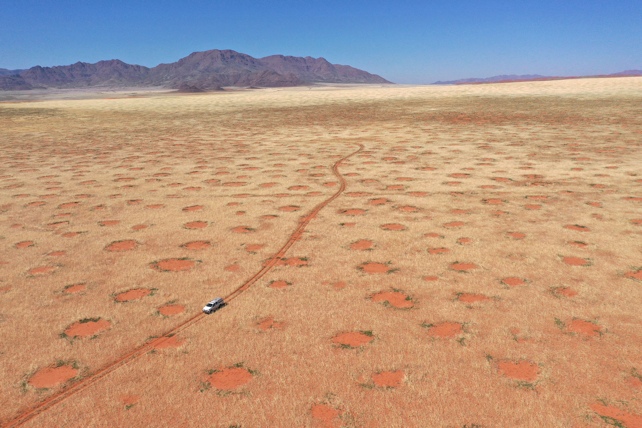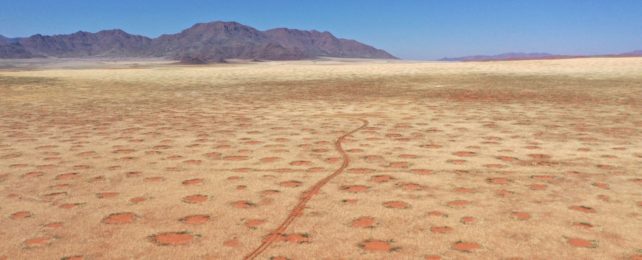Sprawling across a remote swath of the Namib Desert, rugged grasses eke out a living from the region's meager rainfall.
The growth of so much grass in such a harsh environment is impressive, but also mysterious. The grassland is dotted by millions of strange circles, each devoid of grass or other vegetation, that together form an eerie polka-dot pattern of "fairy circles" across the landscape.
Located 80 to 140 kilometers (50 to 87 miles) inland from Namibia's coast, this zone of circular gaps in the grassland is visible from miles around, the study's authors note, and exhibits "an extraordinary degree of spatial ordering."

A typical fairy circle measures anywhere from 2 to 10 meters across, separated from the rest by a distance of up to 10 meters.
Scientists have made steady progress on demystifying Namibia's fairy circles, with leading theories falling into two main camps.
One theory contends the circles are caused by termites feasting on roots, while the other suggests the grasses self-organize to maximize water availability.
Studies have lent credence to each theory, and some research has indicated both termites and self-organization may be behind the fairy circles. But that explanation became trickier after similar circles were reported in Australia in 2016, without a clear link to termites.
Recent research has pointed more firmly toward self-organization, in which the grasses form fairy circles to make the most of scant rainfall, but without necessarily ruling out termites.
In 2020, research led by Stephan Getzin, from the Department of Ecosystem Modeling at the University of Goettingen in Germany, added further support to the water-scarcity scenario, which Getzin and his colleagues described as an example of a Turing pattern.
In their latest study, Getzin and a team of researchers returned to Namibia in hopes of finding even more compelling evidence, investigating fairy circles in 10 regions across the Namib Desert.
Rainfall is rare and irregular in this area. Grasses do sometimes appear within the fairy circles right after it rains, but they typically die soon after, the researchers note, while grass between the circles survives.
Getzin and his colleagues tracked sporadic rains in the 10 regions, examining the grasses, their roots and shoots, and any potential root damage wrought by termites.
They studied the circumstances around dying grass after rainfall, and set up soil-moisture sensors in and around fairy circles to record data at half-hour intervals, beginning in the dry season of 2020 and continuing until the end of 2022's rainy season.
Ten days after rainfall, the interior of the fairy circles had very little new growth, the study found, and what new grass had sprouted was already dying. Twenty days after rainfall, any grass inside the circles was dead, while surrounding grass was "green and soft."
Roots from dead grass inside the circles were as long – or even longer than – roots from outside the circles, suggesting the plants were investing heavily in root growth to search for water. The researchers did not find evidence of termites feeding on the roots, they report.
"The sudden absence of grass for most areas within the circles cannot be explained by the activity of termites because there was no biomass for these insects to feed on," Getzin says. "But more importantly, we can show that the termites are not responsible because the grasses die immediately after rainfall without any sign of creatures feeding on the root."
The soil sensors revealed a slow decline in soil moisture both inside and outside the circles after an initial rainfall, the researchers report, when grasses weren't well-established yet.
Once the surrounding grasses were robust, however, soil moisture vanished quickly everywhere — including inside the fairy circles, despite the lack of grass there to take up the water.
"Under the strong heat in the Namib, the grasses are permanently transpiring and losing water. Hence, they create soil-moisture vacuums around their roots and water is drawn toward them," Getzin says.
"Our results strongly agree with those of researchers who have shown that water in soil diffuses quickly and horizontally in these sands even over distances greater than seven meters."
This is an incredible example of "ecohydrological feedback," the researchers write, in which the barren circles essentially become reservoirs that help sustain grasses at the edges.
This research could also have implications elsewhere, Getzin points out, as this kind of self-organization seems to buffer plants against rising aridity – a problem that's already worsening in some places due to climate change.
"By forming strongly patterned landscapes of evenly spaced fairy circles, the grasses act as ecosystem engineers and benefit directly from the water resource provided by the vegetation gaps," Getzin says.
"In fact, we know related self-organized vegetation structures from various other harsh drylands in the world, and in all those cases the plants have no other chance to survive except by growing exactly in such geometrical formations."
The study was published in Perspectives in Plant Ecology, Evolution and Systematics.
